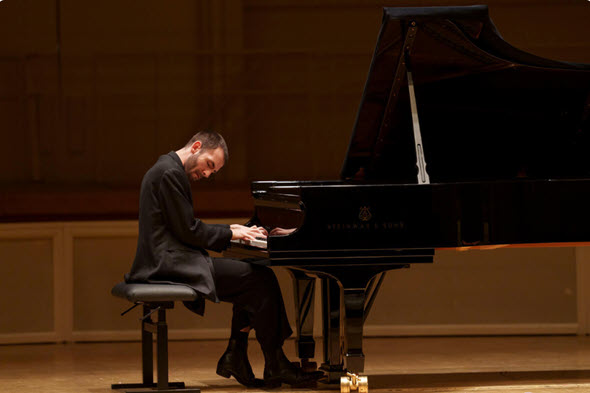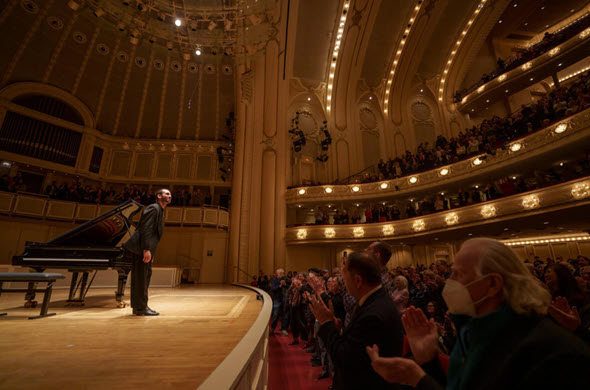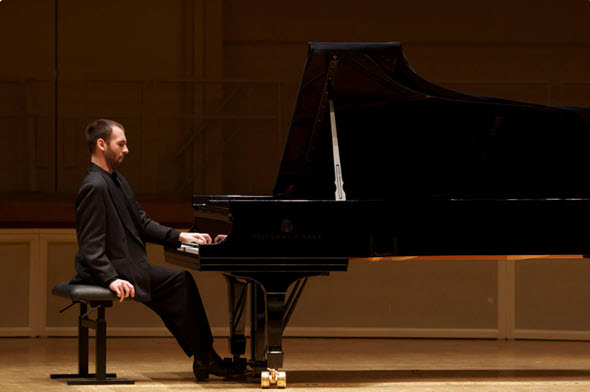Romantic bounty shapes Orchestra Hall debut by Tchaikovsky and Gilmore winner Kantorow
Review: Alexandre Kantorow, piano. Feb. 2 at Orchestra Hall.
By Lawrence B. Johnson
The French pianist Alexandre Kantorow at age 27 made a striking first impression in his Orchestra Hall recital Feb. 2, his debut in the formidable piano series under the aegis of Symphony Center Presents. The young French virtuoso, gold medalist of the 2019 Tchaikovsky Competition and winner of the Gilmore Artist Award in 2024, is a pianistic lion as serious as he is prodigious. His program here was an exercise in grandiose Romanticism, an imposing display of technical wizardry, a veritable summation of keyboard virtuosity.
It was also a bit much of a muchness: work upon densely woven work, either by Liszt or explicitly influenced by that legendary purveyor of heroic pianism. Only at the close did Kantorow finally let in the crisp, fresh air of Brahms’ arrangement for the left hand of Bach’s chaconne from the D minor Violin Partita. Everything up to that point had been artistically, musically, pianistically superb, but all of it more or less of a rhapsodic piece.
Indeed, the first and last works on the recital’s first half share that rather elusive name: Brahms’ Rhapsody in B minor, Op. 79, No. 1, and Bartok’s Rhapsody, Op. 1. Although Brahms labeled the twin piece of his Op. 79 as rhapsodies, they are closer in evocative spirit to, say, Chopin ballades than to the dramatic and ultimately high-intensity, folk-rooted form pioneered by Liszt. Kantorow went straight to the music’s poetic essence in a thoroughly idiomatic performance by turns expansive and pensive, brilliant and lyrical. His playing immediately affirmed a pianist whose finesse and sensibility measured up to his technical mastery.
Bartok’s early Rhapsody is pointedly modeled after Liszt, its opening rumination giving way to an energetic finale, a flamboyant embroidery on folk dance, indeed a virtuoso romp. Kantorow indulged Bartok’s initial musings with patience and expressive warmth before unleashing a conclusion of scintillating power.
Taken separately, the two rhapsodies would have been distinctive delights. But they did not feel altogether separated; between came two grand expressions of Liszt at his most demonstrative and, to give Kantorow his due, electrifying: Transcendental Etude No. 12 in B minor (“Chasse-neige,” or swirling snow) and “Vallée d’Obermann” from “Années de pèlerinage, Première année: Suisse” (Obermann’s Valley, from Years of Travel, First Year: Switzerland).
The Transcendental Etudes are exactly that: otherworldy exercises in musical prestidigitation, and the solitary province of Liszt in his own time. Kantorow made the resonant point that even Liszt’s pianistic peaks have become accessible to the modern-day virtuoso. As its swirling subtitle suggests, the Etude in B minor demands not just speed and agility but also an airy touch, all of which Kantorow delivered with seemingly off-hand ease – before proceeding, sans break to allow any applause, directly into the darker realm of “Vallêe d’Obermann.”
A sort of psychological tone poem, “Obermann” was inspired by a gloomy French novel and its melancholy protagonist who, perhaps not unlike Zarathustra, confronts the vast consciousness of nature and “all the needs and profound and tedious cares that the heart of man can know.” All this did Liszt conjure in his somber side trip to Obermann’s Valley, and compelling was the mirror Kantorow held up to that dark place; it was a soliloquy worthy of Shakespeare’s melancholy Dane.
But not even intermission’s broad hint would deflect the pianist from his single-minded pursuit of high Romanticism. Where one might have wished for a touch of comic relief, say, Stravinsky’s Three Movements from “Petrouchka,” Kantorow plunged ahead with Rachmaninoff’s Sonata No. 1 – in D minor, of course. The sonata is basically a series of tableaux conjuring the three principals of the Faust legend: first its namesake, then unhappy Gretchen and finally the puppet master himself, Mephistopheles.
From Faust’s dreamy visions to Gretchen’s innocent charms and the brilliance of Mephisto’s winner-take-all, Kantorow delivered a concentrated, closely inflected triptych borne on fluid rhythms and gorgeous sound: a glorious capstone to a recital that was met with roaring approval from a packed house.
Well, actually, as I mentioned at the top, there was one piece still to come. To my mind, Kontorow’s conclusion with Brahms’ left-hand adaptation of the Bach chaconne was the encore he ostensibly declined to provide at the close of a program that exceeded two hours in length. Adaptation is hardly an adequate word. It’s a tour de force for the left hand, which must zoom about the keyboard creating weightless counterpoint that crests in sunny D major – and all the while show no sign of effort, stress or fatigue. I daresay left hands were cramping in the house, but not Kantorow’s. In a whirl of pianistic mastery, he fashioned the chaconne into high drama, all lightness and clarity. After that grand immersion in Romantic story-telling, this was exactly the needed epilogue.




